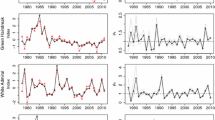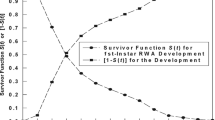Abstract
Equations are derived to represent the time course of the population numbers of the various stages of the flour beetle. The assumption of constant duration of the life stages and the absence of delayed effects leads to equations from which the various population numbers can be calculated in terms of the parameters of the system. Formulae are given for the estimation of many of the latter from observations on population numbers. Calculations show that the principal features of the observed changes in population structure can be accounted for on the basis of a simple model in which it is further assumed that each interaction is proportional to the product of the numbers of the two given interacting stages. A more detailed analysis may require secondary interaction coefficients. Suggestions for estimation of such coefficients are given.
Similar content being viewed by others
Literature
Birch, L. C., T. Park, and M. B. Frank. 1951. “The Effect of Intraspecies and Interspecies Competition on the Fecundity of Two Species of Flour Beetles.”Evolution,5, 116–32.
Park, Thomas. 1948. “Experimental Studies on Interspecies Competition: I. Competition between Populations of Flour Beetles,Tribolium confusum Duval andTribolium castaneum Herbst.”Ecological Monographs,18, 265–308.
Rich, E. R. 1954. “Egg Cannibalis and Fecundity inTribolium.” Unpublished Doctoral thesis, University of Chicago.
Stanley, J. 1932. “A Mathematical Theory of the Growth of Populations of the Flour Beetle,Tribolium confusum Duval.”Can. Jour. Res.,6, 632–71.
—. 1934. “A Mathematical Theory of the Growth of Populations of the Flour Beetle,Tribolium confusum Duval III.”Ibid.,7, 426–33.
Strawbridge, D. W. 1953. “Population Dynamics of the Flour, BeetleTribolium castaneum Herbst.” Unpublished Doctoral thesis, University of Chicago.
Author information
Authors and Affiliations
Rights and permissions
About this article
Cite this article
Landahl, H.D. A mathematical model for the temporal pattern of a population structure, with particular reference to the flour beetle. Bulletin of Mathematical Biophysics 17, 63–77 (1955). https://doi.org/10.1007/BF02481839
Received:
Issue Date:
DOI: https://doi.org/10.1007/BF02481839




